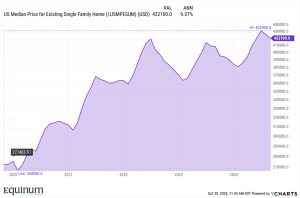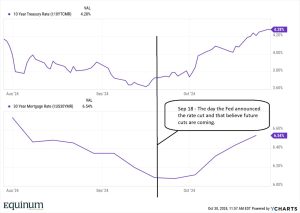When you peek under the hood at inflation data and the latest cost-of-living trends, you might feel some relief upon noticing that, while some high prices still sting, costs are stabilizing overall. All except for one notable, stubborn exception: housing.
Since the pandemic, home prices have shot up dramatically, pushing the dream of homeownership further out of reach for many Americans. Every market has its quirks, but on the whole, the median home price across the U.S. tells the same story – prices are up, and they aren’t trending downward.

To add insult to injury, interest rates were raised in 2022 and 2023 as a mechanism to quell inflation. The natural result should have been a downswing in housing prices. Yet, despite the hikes, home prices didn’t budge. So, now we’re getting hit with the classic one-two punch: higher home prices are prevailing and interest rates have been climbing.
Here’s a typical real-world example: Imagine you had your eye on a $600,000 house back in 2021. With a 30-year mortgage at a 3% rate and a $200,000 down payment, your mortgage bill would have come to an estimated $1,686 a month. Fast forward and today, that same house would likely be priced closer to $800,000, with mortgage rates now hovering around 6.5%. Assuming that the same down payment was applied, the monthly mortgage cost would jump from $1,686 to $3,792 – a staggering difference.
The Fed-fund rate is regulated by the Federal Reserve, while Treasury and Bond rates tend to be controlled by the market – and the rates typically align. However, when the Fed announced a recent half-percent rate cut on September 18th — intended to signal economic stability and control over inflation—many hoped it would signal some relief, especially with the Feds projection of more cuts on the horizon. But ironically, the market has pushed back and treasury bond yields and mortgage rates have actually risen. Economists are practically falling over each other to explain this strange turn of events.

At Equinum, we believe that, while rates might dip a little, the only way we’re likely to see a meaningful drop in home prices or mortgage rates, would be through a recession. In a recession, employment drops and there is less money circulating in the economy; people cannot afford homes and real estate prices fall. The Fed generally responds by cutting interest rates, hoping to stimulate the economy and pull it out of its inertia. While a period of recession may be good news for those seeking to purchase real estate, it comes at the expense of joblessness and unemployment. This solution presents a difficult dilemma: choosing between affordable housing and job stability, an uneasy balancing act that none of us wants to experience.


